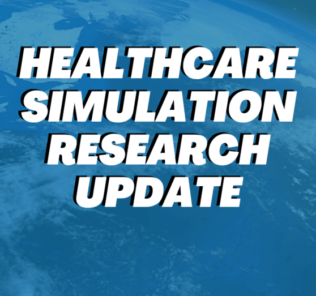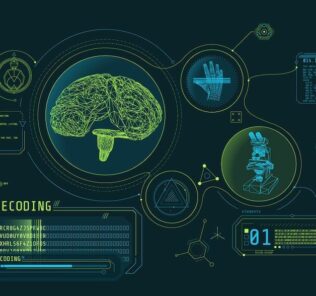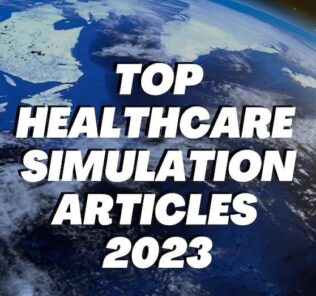To ChatGPT or Not in Nursing Simulation
With the evolution of technology and reported success of ChatGPT, the question is should ChatGPT be used or not in nursing simulation to develop scenarios. High-quality nursing simulation depends on evidence-based research and scenarios go through the peer-review process to maintain high levels of rigor. Research, vetting, and peer review are time-consuming. A busy sim author welcomes tools to streamline the process. This HealthySimulation.com article by Kathy Sokol will discuss if nursing simulation development should use ChatGPT or not.
What Exactly is ChatGPT?
Questions to consider when exploring ChatGPT. Can ChatGPT be a useful tool to assist the nursing simulation faculty in the development of high quality simulation scenarios? Does the technology generate quality scenarios and free up the nurse educator for other work? Will a ChatGPT-created sim scenario suggest relevant goals and outcomes? The idea of using AI to create experiential learning prompts many questions.
Sponsored Content:
Chatbots have existed for decades, but until recently, only a select few had access to the technology. ChatGPT uses artificial intelligence (AI) to respond to questions and requests for information. OpenAI launched ChatGPT in December 2022 to make the free app available to everyone. Healthcare professionals reviewed this latest trend to see how it applied to practice. Nurse educators asked: “Can ChatGPT enhance and improve learning?”
ChatGPT is an AI algorithm used to train artificial neural networks. Many sources provide the input learned by ChatGPT. Resources are not checked and may contain inaccurate or offensive material. Therefore, caution should be exercised when using a document generated by ChatGPT.
ChatGPT Has the Capacity To…
- Generate content such as essays, exam questions, and research summaries.
- Offer tutoring to help students in coursework
- Grade assignments and provide feedback to students
- Help to make online learning more interactive and effective
Concerns about privacy and security arise if ChatGPT is used in academic settings. ChatGPT does not cite resources, which creates the risk of unwitting plagiarism and questionable data reliability. ChatGPT reports must be peer-reviewed before their incorporation into a clinical simulation.
Sponsored Content:
Curious if ChatGPT could help write a nursing scenario? The author of this article asked ChatGPT to create a case study on Type II diabetes. The plan was to incorporate data provided by ChatGPT into a nursing simulation. ChatGPT wrote a medical case study for a middle-aged male patient with newly diagnosed Type II diabetes.
ChatGPT Nursing Simulation Case Study on Type II Diabetes
The case study included a brief medical and social history. The medical assessment reported complaints of frequent thirst, frequent urination, fatigue, slow-healing wounds, blurred vision, and recurring yeast infections. These signs and symptoms are frequently manifestations of poorly controlled blood glucose.
Diagnostic testing revealed an elevated HbA1c, which measures blood glucose levels over the past three months, and an abnormal lipid profile. The American Diabetic Association (ADA) currently recommends not only the HbA1c test to diagnose Type II diabetes but also fasting and random glucose testing. The ADA also suggests a comprehensive metabolic panel to establish baseline serum chemistry since this was a new diagnosis for the patient. ChatGPT did not include the ADA’s recommendations.
Abnormal blood pressure and high BMI (Body Mass Index) were the only vital signs provided. A complete set of vital signs should be taken on all new patients to establish baseline readings for future comparison. BMI is not a typical consideration when diagnosing Type II diabetes. BMI is relevant when designing a diet and exercise plan for someone with Type II diabetes who is underweight or obese.
ChatGPT prescribed poorly defined lifestyle modifications. A personalized diet by a registered dietitian mentioned portion control, incorporation of low-glycemic foods into the diet, and high fiber intake. Meal planning did not emphasize the use of healthy fats. Nutrition experts agree that patients with Type II diabetes should limit simple carbohydrates. Low-glycemic foods include fruits which may be high in sugar. A patient with Type II diabetes is encouraged to eat complex carbohydrates to help regulate blood sugar levels throughout the day. ChatGPT did not discuss carbohydrate consumption.
ChatGPT prescribed the drug Metformin without a specific dose, frequency, or route of administration. An ACE inhibitor was also prescribed to control the patient’s blood pressure. The drug dose, frequency, and route were absent. Prescription drugs require the correct dose, route, and frequency for safe administration.
The patient attended diabetic education classes to learn about self-care, medications, and follow-up visits. Newly diagnosed patients with Type II diabetes may be overwhelmed with the information presented in a group environment. Individualized instruction with a healthcare professional may result in greater compliance.
ChatGPT reported that follow-up visits saw improved HbA1c, an 8% weight loss, and lowered blood pressure. For long-term management, the patient was to continue his diet, exercise, and medication regimen and schedule regular visits with the provider. The patient was not told when to schedule the follow-up visits.
How Did ChatGPT Perform?
A robust simulation scenario needs a focused patient history. ChatGPT did provide a brief past medical summary. Important lab values were missing from the case study. Fasting and random blood glucose, and a basic metabolic profile were missing from the scenario and would need to be added. A set of complete vital signs should be included and was not. Diet orders needed to follow ADA recommendations and were not detailed. ChatGPT gave incomplete patient orders and diagnostic results.
A well-rounded sim scenario for a patient with Type II diabetes includes:
- Teach the patient when and how to test their blood sugar.
- Teach the patient how to use continuous glucose monitoring if prescribed.
- Teach how to manage episodes of hypo and hyperglycemia. ChatGPT did not cover this.
- Teach what can raise or lower blood glucose.
- Teach how to manage sick days and whether or not to adjust medication.
- Teach proper foot care to include daily assessment of all surfaces of the foot and between the toes. ChatGPT did not address foot care.
View the HealthySimulation.com LEARN CE/CME Platform Webinar Using AI, Augmented & Mixed Reality to Enhance Clinical Training Experience to learn more!
Further Discussion
There is a future for ChatGPT in clinical simulation. Presently, technology can be a starting point to writing a nursing scenario. There is, however, a risk of error in not cross-checking the data provided for accuracy and evidence-based practice. ChatGPT was able to design a generic case study for Type II diabetes but did not follow evidence-based practice. At worst, the research was incomplete and lacked critical scrutiny. ChatGPT did not provide enough information to develop a detailed scenario.
The future of AI in higher education shows promise, but ChatGPT is not yet ready to take over the task of simulation writing. ChatGPT needs to be studied further to see where and how AI fits in nursing education. Setting the technology aside would be a mistake, as would blindly adapting ChatGPT at face value. Rather than fear AI’s evolution, educators should embrace the technology for the potential to augment all forms of simulated learning.
To Learn More About OpenAI in Nursing Education!
Resources
- ChatGPT Type II Diabetes Case Study
- Archibald, M. & Clark, A. (2023). ChatGTP: What is it and how can nursing and health science education use it? [Editorial]. Journal of Advanced Nursing, https://onlinelibrary.wiley.com/doi/10.1111/jan.15643, 1-4.
- Berland, L. & Hardy, S. (2023). Fighting Obsolescence: Professional Assessment in the Era of ChatGPT. Applied Radiology, May/June, 20-24.
Kathy Sokol lived most of her adult life in Florida before “retiring” to Las Vegas. She has been a registered nurse for over 30 years and a nurse educator since 2005. Kathy has a masters degree in nursing education and earned Master Instruction certification from Chamberlain University College of Nursing.
She set up and managed simulation labs on several campuses throughout the country. Kathy collaborated on a course called Sim 101 to educate faculty on how to enrich student learning through simulation. In 2016, Kathy and her team did a presentation at IMSH on how to efficiently open a sim lab while saving time and money.
Kathy was initiated into Sigma Theta Tau International Honor Society. She was a nominee for the Daisy Faculty Nurse Award. She has been published in RN Magazine, is a regular contributor on LinkedIn and has an adult learning page on Facebook. She is currently working on a book about change.
Kathy lives in Las Vegas with her husband. She is a visiting professor at Chamberlain University College of Nursing.
Sponsored Content:


















